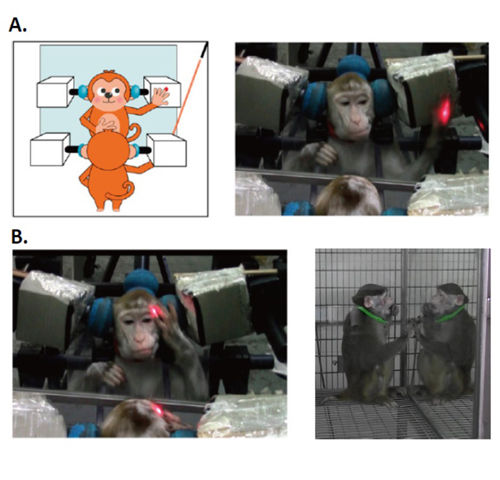Time:2017-02-14
A recent study published in PNAS demonstrated that monkeys showed spontaneous mirror self-recognition (MSR) behaviors after learning precise visual-proprioceptive association for mirror images. This work was performed by researchers in Dr. GONG Neng’s team at the Non-human Primate Facility of the Institute of Neuroscience, Chinese Academy of Sciences.
Self-awareness is a form of higher intelligence that can be revealed by mirror self-recognition in humans. Testing MSR has become the main approach to examining the existence of self-recognition in animals, and only a few species have passed this test. In the standard face mark test for demonstrating MSR, an odorless nonirritant dye is placed on the face of the subject (without the subject’s awareness) that can only be seen in the mirror. Humans and several species of great apes could pass the test by touching the dye mark after looking at themselves in the mirror. However, it remains controversial whether failing the MSR test is a result of the lack of an animal’s self-recognition ability or the inadequacy of the mirror test.
In a previous study published in 2015, Dr. GONG Neng's team reported such MSR behaviors in monkeys after several weeks of visual-somatosensory association training, by applying an irritant laser light on the monkey’s face in front of the mirror. However, this direct training on the monkey's face by the sensation-induced face-touching caused controversy and criticism as to whether the observed MSR behaviors were just a simple conditioned response. In this new study, researchers designed a new training strategy in which the monkey was only trained to use the mirror as an instrument to find hidden objects. They trained head-fixed monkeys seated in front of a mirror to touch, with spatiotemporal precision, a laser pointer light spot on an adjacent board that could only be seen in the mirror (Fig. A). After several weeks of training, when the same laser pointer light spot was projected to the monkey’s face, a location not used in training, all three trained monkeys successfully touched the face area marked by the light spot in front of a mirror (Fig. B). All trained monkeys passed the standard face mark test for MSR both on the monkey chair and in their home cage. Importantly, distinct from untrained control monkeys, the trained monkeys showed typical mirror-induced self-directed behaviors in their home cage, such as using the mirror to explore normally unseen body parts (Fig. B).
In this study, visual-proprioceptive training of rhesus monkeys to precisely locate objects outside the body has resulted in self-directed behaviors in front of a mirror. This work may shed light on the neural basis of MSR and self-awareness. Furthermore, this study suggests that the failure to demonstrate MSR in animals could be attributed to the lack of the ability in visual-proprioceptive association for the mirror images, rather than the absence of bodily self-consciousness. This work also underscores the importance of developing new experimental approaches in studying self-recognition and self-awareness, which may even exist in many non-primate species.
This work entitled “Spontaneous expression of mirror self-recognition in monkeys after learning precise visual-proprioceptive association for mirror images” was published online in PNAS on February 13, 2017. CHANG Liangtang and ZHANG Shikun performed this study under the co-supervision of Dr. GONG Neng and Dr. POO Mu-ming. The work was supported by the MoST 973 Program of China (2011CBA00400), Strategic Priority Research Program of the CAS (XDB02020100), and CAS Youth Innovation Promotion Association.

Figure legend:(A)Visual-proprioceptive association training; (B)Mirror-induced self-directed behaviors
 附件下载:
附件下载: